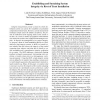36 search results - page 7 / 8 » Usability and Privacy in Identity Management Architectures |
SP
1999
IEEE
13 years 9 months ago
1999
IEEE
Psychological acceptability has been mentioned as a requirement for secure systems for as long as least privilege and fail safe defaults, but until now has been all but ignored in...
EGOV
2005
Springer
13 years 10 months ago
2005
Springer
In this paper we propose a solution to secure interoperability between electronic ID management infrastructures enabling the provision of cross-border eServices to mobile citizens....
MOBISYS
2008
ACM
14 years 4 months ago
2008
ACM
Automotive traffic monitoring using probe vehicles with Global Positioning System receivers promises significant improvements in cost, coverage, and accuracy. Current approaches, ...
ACSAC
2007
IEEE
13 years 11 months ago
2007
IEEE
Integrity measurements provide a means by which distributed systems can assess the trustability of potentially compromised remote hosts. However, current measurement techniques si...
IEEEARES
2009
IEEE
13 years 11 months ago
2009
IEEE
Dynamic taint analysis (DTA) is a technique used for tracking information flow by propagating taint propagation across memory locations during program execution. Most implementat...


